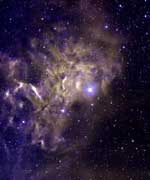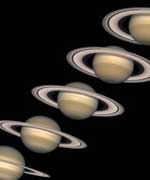
Image credit: NOAO/AURA/NSF
Monday, February 28 – Let’s start tonight enjoying the early dark skies and go to our maps west of the M36 and M38 to identify AE Aurigae. As an unusual variable, AE is normally around 6th magnitude and resides approximately 1600 light years distant. The beauty in this region is not particularly the star itself but a faint nebula in which it resides known as IC 405, an area of mostly dust and very little gas. What makes this view so entertaining is that we are looking at a “runaway” star. It is believed that AE once originated from the M42 region in Orion. Cruising along at a very respectable speed of 80 miles per second, AE flew the “stellar nest” some 2.7 million years ago! Although the IC 405 is not directly related to AE, there is evidence within the nebula that areas have been cleared of their dust by the rapid northward motion of the star. AE’s hot, blue illumination and high energy photons fuel what little gas is contained within the region as well as reflects off the surrounding dust. Although we cannot “see” with our eyes like a photograph, together the pair form an outstanding view for the small backyard telescope and it is known as “The Flaming Star.”
Tuesday, March 1 – George Abell was born on this day in 1927. Abell was the man responsible for cataloging 2712 clusters of galaxies done with the Palomar sky survey completed in 1958. Using these plates, Abell put forth the idea that the grouping of such clusters distinguished the arrangement of matter in the universe. He developed the “luminosity function”, which shows relationship with brightness and number of members in each cluster, giving rise to distances. Abell also discovered a number of planetary nebulae and developed the theory (along with Peter Goldreich) of their evolution from red giants. Mr. Abell was a fascinating lecturer and a developer in many television series dedicated to explaining science and astronomy in a fun and easy to understand format. Abell was also a president and member of the Board of Directors for the Astronomical Society of the Pacific, as well as serving on the American Astronomical Society, Cosmology Commission of the International Astronomical Union, and accepted editorship of the Astronomical Journal just before he died.
Would you like to study an Abell galaxy cluster? Then let me sweep you away to Abell 426 just two degrees east of previous study star – Algol. I caution you that this is not an area that can be seen with the average telescope, but for those of you with very large aperture you will find a study region incredibly worth your time and attention. The brightest of this group of galaxies in the NGC 1275 at magnitude 12.7. As an incredible radio source, the NGC 1275 is thought to be two galaxies actually in the process of passing through one another. Depending upon both your seeing conditions and aperture, Abell 426 may reveal anywhere from 10 to 24 small galaxies that range to close to magnitude 15. Given the fact that there are around 233 galaxies in this cluster alone, it’s a privilege to be able to spot a few!
Abell 426 has been a longstanding favourite of mine. It is a curious galaxy cluster in the respect that the finer the night, the more galaxies will reveal themselves. The first study lays right in the field with a star and the NGC 1224 requires wide aversion. It is faint, round, and shows some concentration toward the nucleus with patience. Held indirect, this small galaxy has a UGC-like signature. Next stop on the hop is the NGC 1250 which is very diffuse, small and requires wide aversion. While allowing the eye to bounce around the field, it is possible to make out a slight north/south tilt to this galaxy that may indicate it to be a spiral. Curiously enough, it is during this motion that a pinprick of a nucleus can be detected. Pushing on toward the heart of the Perseus Galaxy cluster, the next destination is a chain of three. First study mark is the NGC 1259. Extreme aversion only… Very, very diffuse and faint, it can only be caught by focusing attention on the tiny star in the westward drift. The NGC 1260 only requires slight aversion, however. It is small and somewhat diffuse – definitely ovoid in structure – as well as the easiest to see of these three! The NGC 1264 also requires very wide aversion. Very faint and diffuse, very round – and very challenging! Now, triangulating with this series, it’s time to go for the NGC 1257 – very faint, diffuse and small with a concentration toward the core, it holds a little surprise – there’s a tiny star at the northeast end that allows one to see upon wide aversion that the galaxy itself seems to migrate to the northeast/southwest.
From here we have the option of continuing on the same trajectory or doing a lateral “move”. Past experience dictates that maps don’t always reveal everything there is to be seen in such a cluster including galaxies that masquerade as stars. The “heart” of Abell 426 is so dense that identification is extremely difficult! The NGC 1271 skirts the most populated part of this Abell cluster and requires super wide aversion to detect a very faint, very small patch that is barely visible. Even experience can draw nothing more than a slightly regular contrast change in this area. Next up is an extremely challenging triple – the NGC 1267, NGC 1268 and NGC 1269 are three incredibly tiny, very diffuse round gems that would be totally indistinguishable at lower power. NGC 1273 is faint – it requires aversion, but the brighter core region holds up to indirect vision. The NGC 1272 is also round – almost planetary in appearance. The NGC 1270 is very diffuse and takes wide aversion. It contains a very small, almost stellar nucleus. NGC 1279 is faint, diffuse, and stretches just ever so slightly, like a thin smear held at slight aversion to the north/south. It is even with no nucleus present. The NGC 1274 is very faint and very diffuse, even, and is best seen while concentrating on the NGC 1279 – revealing an incredibly small, misty oval. The NGC 1275 is very bright compared to all the previous studies. It most definitely has a bright and easily held direct nucleus. Going for a pair, we find the NGC 1282 to be diffuse, slight in size and quite ovoid – very even in structure with no hint of a nucleus even a full avert. The companion, NGC 1283, is very diffuse and we probably couldn’t see it except for there are some small field stars that triangulate in this area that leads to its foggy apppearance. Now for the NGC 1294 and NGC 1293 – wide aversion shows two round fuzzies with prickly nucleus structure. The pair looks like two impossibly small dandelions waiting to be scattered on the cosmic winds…
Best of luck on your Abell quest!
Wednesday, March 2 – How about tonight if we relax a bit and look for an open cluster that is viewable in binoculars and small scopes for the majority of both the northern and southern hemispheres? Our marker for this hop will be Xi Puppis and you will find M93 approximately two finger-widths (two degrees) northwest and almost right on the galactic equator.
Cataloged by Charles Messier in March of 1781, this wonderfully bright grouping (overall magnitude 7) of around 80 stars contains a wealth of various stars types that are roughly around 3400 to 3600 light years away. In binoculars the view is incredibly rich, but a telescope adds so much more! Towards the center, the viewer will note a wedge-shaped collection. At the heart of this is an easy double star and another on the western edge. The very brightest of these stars are young, hot and blue with a stellar population quite similar to the Plieades. How old you ask? A very modest one million years….
Thursday, March 3 – Get up early! There will be occultations galore for North America! Starting with the east coast, the Moon will occult Sigma Scorpii in the wee hours. Check out IOTA for specifics. On a broader note, (and the same morning!) the Moon will also occult Antares just a few hours later. It doesn’t matter if you are not into critical timing, you really should take advantage of this opportunity. Watching this kind of event is incredibly inspiring – even if you just view it with your eyes!
Tonight let’s try something a bit different! We’ll be heading about a degree and a half south/southwest of Alpha Monocerotis to find a magnitude 10 open cluster known as Melotte 72. Achievable in a good 6 to 10 inch scope, this loose collection of around 50 or so stars appears in a wonderful “delta wing” pattern! Continuing another degree and a half south will bring you to 7th magnitude Melotte 71. Easily capturable in the small scope, this unique small cluster contains around 100 stars. Remember where you found them, for this will be our guide to other studies!
Friday, March 4 – In 1835, Giovanni Schiaparelli opened his eyes for the very first time and opened ours with his accomplishments! As the director of the Milan Observatory, Schiaparelli (and not Perceval Lowell) was the fellow who popularized the term “Martian canals” somewhere around the year 1877. Far more importantly, Schiaparelli was the man who made the connection between the orbits of meteoroid streams and the orbits of comets almost eleven years earlier!
How about if we take a look at some comets tonight?
C/2004 Q2 Machholz is still holding strong and still viewable with just binoculars. Happily turning around Polaris, the “Magnificent Machholz” will be quite near the Cepheus/Camelopardalis border. C/2003 K4 LINEAR is still within large binocular range and can be found north of Tau 5 Eridanus. C/2005 A1 LINEAR makes a spectacular morning appearance for the small scope just south of Alpha Apus. In the north, comet C/2003 T4 LINEAR should have brightened to magnitude 9 and be very near Kappa Delphini in the hours before dawn. 141P/Machholz scoots into Aquarius for those around 40 degrees just after sunset, but will be a challenge at magnitude 10. Break out the big scopes and see if you can pick out 12th magnitude 78P/Gehrels so close to Theta 1 and Theta 2 Tauri… And since you’ve got the power out, take a look at 32P Comas/Sola just a few degrees from the Plieades!
Saturday, March 5 – Today is the birthday of Gerardus Mercator, famed mapmaker, who started his life in 1512. Mercator’s time was a rough one for astronomy, but despite a prison sentence and the threat of torture and death for his “beliefs”, he went on to design a celestial globe in the year 1551. If you are up early this morning, you can see the lunar feature named for Gerardus! While the most prominent crater of all will be Gassendi, we will use it as our starting point and head south. The dark expanse of Mare Humorum comes next and south of it and on the terminator you will find a heart-shaped area known as Palus Epidemiarum. On its northern shore you will see the outlined circle of crater Campanus. On this crater’s southeast border and mostly shadowed is the remains of Mercator!
Tonight let’s head back to Alpha Monocerotis. Remembering our “drop” for Mel 71 and 72, continue south about 2 more degrees. In the finderscope, you will see an L-shaped collection of 4 stars. Going to the eyepiece at low power – wide field, you are in for a double treat as we view two open clusters. The northernmost is NGC 2423, but the most interesting (and bright!) is more commonly known as M47.
M47 was known long before Messier’s time because it approaches unaided eye visibility. When Charles discovered this 5th magnitude beauty February 19, 1771 he described it as a brighter neighbor of the M46, but incorrectly logged its position! Thus was born the “missing Messier” until 1934 when Oswald Thomas identified it. It’s rather funny to note that because of a “messy mistake” that William Herschel also discovered it some fourteen years later! Even the later Herschel and Dreyer had problems with this one… But you won’t have any problems as you view this bright cluster in either binoculars or telescope! It is a loose open cluster around 78 million years old that contains around 50 stars of various magnitudes in a region about the same size of the full moon. At roughly 1600 light years away, you might even get a glimpse of an orange giant or two, along with beautiful double Sigma 1121 in its center!
Sunday, March 6 – Although almost no one likes to get up early on a Sunday morning, set your alarm for around 5:00 am. and carpe diem! This morning the splendid remaining crescent of the Moon will put on a spectacular showing called a “conjunction” with the Red Planet – Mars! You’ll find the stars of summer have quietly moved since since we viewed them last and Mars is now in Sagittarius. Shining every bit as brilliant as its namesake, Antares, Mars will be just a bit more than a fist’s width (6 degrees) above the Moon. Don’t miss it!
If you get a chance to see sunshine today, then celebrate the birthday of Joseph Fraunhofer who was born in 1787. As a German scientist, Fraunhofer was truly a “trailblazer” in terms of modern astronomy. His field? Spectroscopy! After having served his apprenticeship as a lens and mirror maker, Fraunhofer went on to develop scientific instruments, specializing in applied optics. While designing the achromatic objective lens for the telescope, he was watching the spectrum of solar light passing through a thin slit and saw the dark lines which make up the “rainbow bar code”. Fraunhofer knew that some of these lines could be used as a wavelength “standard” so he began measuring. The most prominent of the lines he labeled with letters that are still in use today! His skill between optics, mathematics and physics led Fraunhofer to design and build the very first diffraction grating which was capable of measuring the wavelengths of specific colors and dark lines in his solar spectrum. Did his telescope designs succeed? Of course! His work with the achromatic objective lens is the design still used in modern telescopes!
And for our “pasta resistance” of the week? Let’s head right back to the area we’ve been studying and go about a degree and a half east/south east of the M47. Tonight we’ll be studying an object that once again is viewable to most of the northern and southern hemisphere and is bright enough to be caught in binoculars. Its name? M46!
Discovered on February 19, 1771 by Charles Messier, the M46 opened a new chapter for our hero as he had just published his first list. At a visual magnitude of 6, this rich galactic cluster could contain up to 500 members and is around 300 million years old. Slightly smaller than a lunar diameter, it will appear as a “dust ball” (along with the M47) to binoculars, but holds a wonderful surprise for the telescope! On its northern border is a “bright star” which under power turns into planetary nebula, NGC 2438. Is it actually part of the M46? Well, science thinks not. The planetary nebula is actually receding far faster than the stars around it. On the average, the M46’s distance is about 4600 light years, while the nebula is around 2900. The planetary itself takes more than a billion years to reach this point in evolution and our stellar “swarm” just isn’t quite that old! No matter how we “slice and dice” this particular deep sky object, the fact remains… We get two for the price of one! Two Messiers in the field for binoculars – and two DSOs in the field of view for telescopes!
Hey! Isn’t it great to enjoy dark skies again? I love the Moon, but there’s no place like space! Until next week? May all your journeys be at light speed! … ~Tammy Plotner




